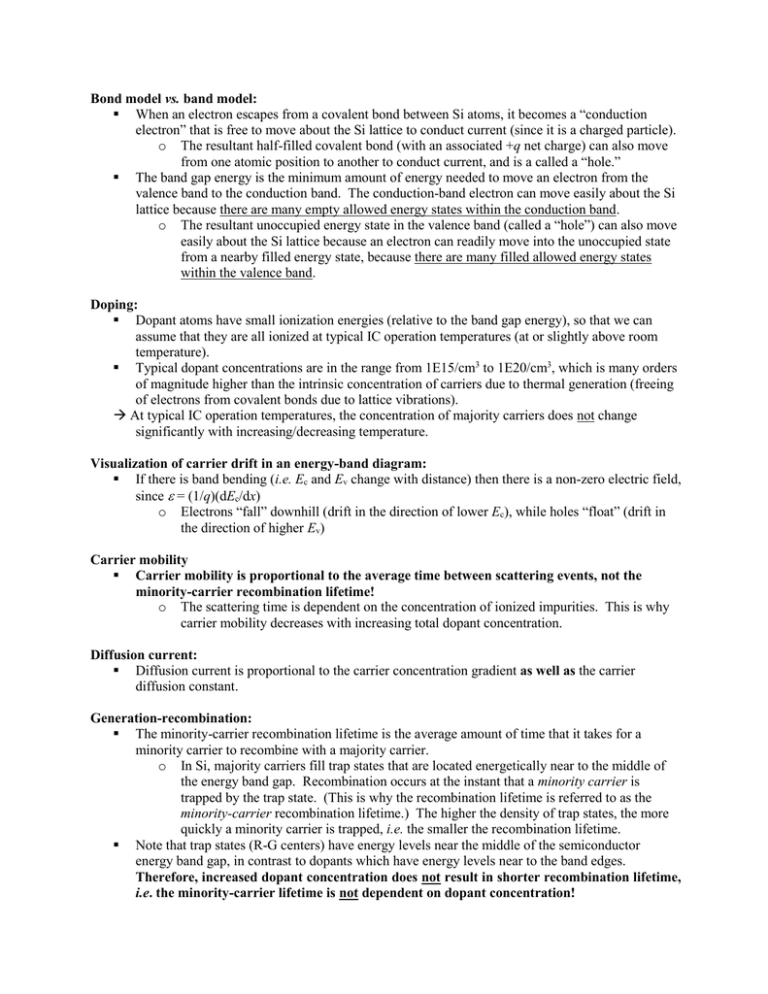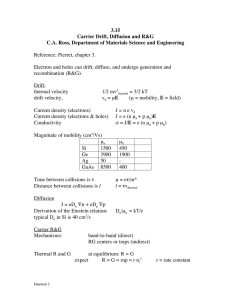quiznotes
advertisement

Bond model vs. band model: When an electron escapes from a covalent bond between Si atoms, it becomes a “conduction electron” that is free to move about the Si lattice to conduct current (since it is a charged particle). o The resultant half-filled covalent bond (with an associated +q net charge) can also move from one atomic position to another to conduct current, and is a called a “hole.” The band gap energy is the minimum amount of energy needed to move an electron from the valence band to the conduction band. The conduction-band electron can move easily about the Si lattice because there are many empty allowed energy states within the conduction band. o The resultant unoccupied energy state in the valence band (called a “hole”) can also move easily about the Si lattice because an electron can readily move into the unoccupied state from a nearby filled energy state, because there are many filled allowed energy states within the valence band. Doping: Dopant atoms have small ionization energies (relative to the band gap energy), so that we can assume that they are all ionized at typical IC operation temperatures (at or slightly above room temperature). Typical dopant concentrations are in the range from 1E15/cm3 to 1E20/cm3, which is many orders of magnitude higher than the intrinsic concentration of carriers due to thermal generation (freeing of electrons from covalent bonds due to lattice vibrations). At typical IC operation temperatures, the concentration of majority carriers does not change significantly with increasing/decreasing temperature. Visualization of carrier drift in an energy-band diagram: If there is band bending (i.e. Ec and Ev change with distance) then there is a non-zero electric field, since = (1/q)(dEc/dx) o Electrons “fall” downhill (drift in the direction of lower Ec), while holes “float” (drift in the direction of higher Ev) Carrier mobility Carrier mobility is proportional to the average time between scattering events, not the minority-carrier recombination lifetime! o The scattering time is dependent on the concentration of ionized impurities. This is why carrier mobility decreases with increasing total dopant concentration. Diffusion current: Diffusion current is proportional to the carrier concentration gradient as well as the carrier diffusion constant. Generation-recombination: The minority-carrier recombination lifetime is the average amount of time that it takes for a minority carrier to recombine with a majority carrier. o In Si, majority carriers fill trap states that are located energetically near to the middle of the energy band gap. Recombination occurs at the instant that a minority carrier is trapped by the trap state. (This is why the recombination lifetime is referred to as the minority-carrier recombination lifetime.) The higher the density of trap states, the more quickly a minority carrier is trapped, i.e. the smaller the recombination lifetime. Note that trap states (R-G centers) have energy levels near the middle of the semiconductor energy band gap, in contrast to dopants which have energy levels near to the band edges. Therefore, increased dopant concentration does not result in shorter recombination lifetime, i.e. the minority-carrier lifetime is not dependent on dopant concentration! o Trap states are associated with crystalline defects and “deep-level” impurities such as gold. To shorten the minority-carrier lifetime, such impurities are added to the semiconductor. Schottky diodes (metal-semiconductor contacts): Only the majority carriers which have enough kinetic energy to surmount the barrier can diffuse into the metal. o The energetic distribution of carriers within the conduction band (and valence band) depends on temperature: the higher the temperature, the more the conduction electrons are “spread out” to higher energy levels associated with higher electron kinetic energy. (Similarly, the higher the temperature, the more the valence holes are “spread out” to lower energy levels associated with higher hole kinetic energy.) Note that the total number of majority carriers does not increase significantly with temperature, for T 300K. This is because the dopants are fully ionized, and typical dopant concentrations are orders of magnitude higher than the intrinsic concentration of carriers, so that the concentration of majority carriers is equal to the net dopant concentration. Under forward bias, the barrier to majority carrier flow into the metal is decreased, so that current flows easily. Under reverse bias, the barrier to majority carrier flow into the metal is increased, so that current does not flow easily. The total amount of band-bending in the semiconductor is q(Vbi+VA) for metal contact to p-type semiconductor. (The total amount of band-bending in the semiconductor is q(Vbi-VA) for metal contact to n-type semiconductor.) o The built-in potential Vbi is equal to the difference between the metal work function and the semiconductor work function. It is the total amount of band bending in the semiconductor for VA = 0 V (i.e. under equilibrium condition). o The depletion width increases with the total amount of band bending. Electrostatics: The derivative of the electric field is directly proportional to the charge density (Poisson’s Equation). Thus, the slope of the vs. x plot in a depletion region (where the mobile carrier concentrations are approximated to be zero) should be proportional to the dopant concentration in the semiconductor. o As the depletion width in a M-S junction or p-n junction changes with the applied bias, the slope of the vs. x plot does not change, because the dopant concentration does not change with applied bias. The electric field distribution is obtained by integrating the charge density distribution. The electric potential distribution V(x) is obtained by integrating the electric field distribution. Thus, the larger the potential drop across a semiconductor region, the more integrated charge there must be in the semiconductor. If the total potential drop across the semiconductor is increased due to an applied bias, then the depletion width is increased (to satisfy the requirement that the integrated charge must be greater, given that charge density cannot change because it is determined by the dopant concentration, which does not change with an applied bias). pn junction: Note that the electric field within the depletion region always “points” in the direction that moves holes (minority carriers on the n-side) into the p-side, and electrons (minority carriers on the pside) into the n-side. Forward-bias (VA > 0) current is due to diffusion of majority carriers across the junction. o Once the carriers diffuse across the junction, they continue to diffuse in the quasi-neutral regions as minority carriers. For a long-base diode (in which the width of the quasi-neutral region is much larger than the minority-carrier diffusion length), the diffusing minority carriers are annihilated by the process of recombination. The excess minority carrier concentration profile is an exponentially decaying function of distance, going to zero at the metal contact. For a short-base diode (in which the width of the quasi-neutral region is much smaller than the minority-carrier diffusion length), very few minority carriers will recombine with majority carriers as they diffuse through the quasi-neutral region. Since few minority carriers are “lost” due to recombination in this case, the minority-carrier diffusion current is ~constant throughout the quasi-neutral region. Thus, the minority-carrrier concentration profile is a ~linear function of distance. (The excess minority carrier concentration profile is a linearly decreasing function of distance, going to zero at the metal contact.) o Under forward bias, pn > ni2 in the quasi-neutral regions, so that there is net recombination in these regions. (If the quasi-neutral region is “short,” very few of the excess minority carriers will recombine before they diffuse through the quasi-neutral region.) Reverse-bias (VA < 0) current is due to drift of minority carriers across the junction. It is determined by the rate at which minority carriers are introduced (either by diffusion from the quasi-neutral region, or by generation) into the depletion region. o Under reverse bias, pn < ni2 in the quasi-neutral regions, so that there is net generation in these regions. Minority carriers that are generated in quasi-neutral regions ~within a diffusion length of the depletion region can diffuse to the depletion region, to be “collected” across the junction. Transient response: The speed at which a diode can be turned off (when the bias changes from forward to reverse) is limited by the rate at which the excess minority carriers in the quasi-neutral regions are removed, either by recombination with majority carriers or by diffusion. For example, excess holes stored in the quasi-neutral n side are removed by recombining with electrons on the n side and/or diffusing back into the p side to flow out of the p-side contact. (Recall that only majority carriers flow across a metal-semiconductor contact.) Bipolar Junction Transistor: The common-emitter d.c. current gain is defined to be the ratio of collector current to base current (i.e.dc IC / IB) when the BJT is biased in the active mode. When the BJT is biased in saturation mode, IC < dcIB because the collector is injecting carriers into the base region in the direction opposite to carriers (injected from the emitter) being collected into the collector region so that the net collector current is smaller than in active mode. To achieve high emitter injection efficiency in a homojunction BJT, the emitter should be much more heavily doped than the base (so that many more carriers are injected from the emitter into the base, as compared with carriers injected from the base into the emitter). The emitter does NOT necessarily have to be degenerately doped, to achieve high emitter injection efficiency and therefore high common-emitter d.c. current gain. The charge control model (Equation 12.14 in Pierret) is only valid for active mode operation and only if recombination is the dominant component of base current. (Thus, B/t = dc only if recombination is the dominant component of base current.) In modern BJTs, the dominant component of base current is actually injection of carriers into the emitter. In saturation mode, both the emitter junction and the collector junction are forward biased. The forward bias on the collector junction is always less than the forward bias on the emitter junction. (Otherwise, the emitter current would not be positive!) In active mode, the collector current is essentially equal to the minority carrier diffusion current in the base. (This is because the collector junction is reverse biased, so that the only current which flows is the reverse current due to minority carriers diffusing into the depletion region.) o The minority carrier diffusion current is proportional to the gradient (slope) of the minority-carrier concentration profile as well as the minority carrier diffusion constant. The base transit timet is the time that it takes a minority carrier to traverse the quasi-neutral base. o The smaller the minority carrier diffusion constant, the more slowly minority carriers diffuse across the base and hence the longer the base transit time. o The shorter the quasi-neutral base width, the shorter the base transit time. o The minority carrier recombination lifetime in the base, B, is not related tot unless recombination current is the dominant component of base current (which is rarely the case in modern BJTs). MOS Capacitor: Notation: The voltage drop in the semiconductor is S. This is different than the semiconductor work function, S. MOSFET: In the ON-state (when |VGS| > |VT|), the MOSFET operates as a voltage-controlled resistor, since current flow between the source and drain is limited by the rate at which carriers in the inversion layer drift across the channel. In the OFF-state (i.e. in the sub-threshold regime, when VGS| < |VT|), the MOSFET operates similarly to a BJT, since current flow is limited by thermionic injection of carriers over the source-channel junction potential barrier. The rate at which carriers diffuse into the channel (from the source) determines the transistor current. For amplifier applications, the MOSFET is biased in the saturation region of ON-state operation. Thus, its operation as an amplifer cannot be compared directly to that of a BJT since the dominant mechanism of MOSFET current flow is carrier drift (not diffusion as in a BJT). The field-effect mobility (eff) is a strong function of the effective vertical electric field seen by the carriers in the inversion layer. This is because the carriers are attracted to the gate-dielectric interface by the vertical electric field, in the ON state for an enhancement-mode MOSFET. Thus, the carriers scatter more frequently as they drift from the source to the drain, as compared to carriers drifting through a uniformly doped semiconductor resistor with the same lateral electric field. The vertical electric field seen by the inversion layer (in the MOSFET ON state) is dependent on the following parameters: o Gate voltage: The higher VGS is, the larger the voltage dropped across the gate dielectric and hence the larger the vertical electric field (in the gate oxide as well as at the channel surface). o Gate-dielectric thickness: For a fixed gate voltage (i.e. fixed voltage dropped across the gate dielectric), the vertical electric field in the gate oxide -- and hence in the semiconductor channel at the channel surface -- increases with decreasing gate Toxe. o Threshold voltage: VT is larger for a more heavily doped channel. In order to invert the surface in this case, more energy-band bending across a smaller distance (WT) is needed; therefore, the vertical electric field at the threshold condition is higher. VT is larger if the body-source pn junction is reverse biased. Recall that the peak electric field in the depletion region of a pn junction increases with increasing reverse bias (due to increasing depletion width, hence increasing integrated charge density on either side of the junction). Similarly, the electric field seen by the inversion layer will increase with increasing reverse body bias. The bulk charge factor m accounts for the fact that the areal depletion charge density Qdep (units: C/cm2) is not constant along the channel; it increases in magnitude toward the drain (i.e. with increasing y). Since the total areal charge density in the semiconductor must be constant along the channel, this means that the areal inversion charge density (Qinv) decreases in magnitude toward the drain. The simplistic “square law” I-V equations for the MOSFET are derived based on the assumption that Qdep (hence Qinv) is constant along the channel and therefore they overestimate the transistor current IDS. The “bulk-charge model” I-V equations properly account for the variation in Qdep (hence Qinv) with y, by incorporating the parameter m. Note that since Qinv decreases in magnitude toward the drain, the drain voltage at which the inversion layer becomes pinched off at the drain end, VDsat, is reduced due to the bulk charge effect. o m increases with channel/body doping because the channel depletion depth WT decreases, so that the areal capacitance between the channel surface and the quasi-neutral body, Cdep, increases relative to the areal gate oxide capacitance, Cox. The body effect factor accounts for the fact that the threshold voltage is dependent on the bias between the body and source. If the body-source junction is reverse-biased, the voltage dropped between the channel surface and quasi-neutral body is increased so that Qdep is increased. Thus, Qinv is decreased, i.e. the threshold voltage is effectively increased (since Qinv VGS – VT).






